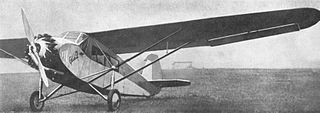Related Research Articles

The Yermolayev Yer-2 was a long-range Soviet medium bomber used during World War II. It was developed from the Bartini Stal-7 prototype airliner before the war. It was used to bomb Berlin from airbases in Estonia after Operation Barbarossa began in 1941. Production was terminated in August 1941 to allow the factory to concentrate on building higher-priority Ilyushin Il-2 ground-attack aircraft, but was restarted at the end of 1943 with new, fuel-efficient, Charomskiy ACh-30B aircraft Diesel engines.

The Yakovlev Yak-2 was a short-range Soviet light bomber/reconnaissance aircraft used during World War II. It was produced in small numbers, and most of them were destroyed during the opening stages of Operation Barbarossa.

The Yakovlev Yak-16 was a Soviet light transport that first flew in 1947. Prototypes were built in both passenger and military cargo versions, but neither was put into production as the Antonov An-2 was felt to be more versatile.
OKB Chyetverikov was a Soviet aircraft design bureau headed by designer Igor Vyacheslavovich Chyetverikov at the TsAGI Menzhinskii factory in 1931 in order to produce flying boat designs.

The Tupolev Tu-12 was an experimental Soviet jet-powered medium bomber developed from the successful piston-engined Tupolev Tu-2 bomber after the end of World War II. It was designed as a transitional aircraft to familiarize Tupolev and the VVS with the issues involved with jet-engined bombers.

The Polikarpov I-3 was a Soviet fighter designed during the late 1920s. It entered service in 1929, but was retired in 1935 with the advent of fighters with higher performance.

The DAR, was a twin-engined flying boat designed and produced in the USSR from 1934.
The ARK-Z-1, was a single-engined transport aircraft designed and produced in the USSR from 1933.

The Stal-2 was a Russian mid-range passenger aircraft.
The LK was a two-seat cabin aircraft designed and built in the USSR from April 1936.
The RK was a two-seat cabin aircraft designed and built in the USSR from April 1936.
The RK-I was a two-seat cabin aircraft designed and built in the USSR from October 1938.
The LK-1, , was a four-seat cabin aircraft designed and built in the USSR from 1933.
The LK-4, was a tandem two-seat trainer aircraft designed and built in the USSR from 1933.
The P-3, (a.k.a. LIG-5, was a multi-purpose trainer aircraft designed and built in the USSR from 1936.
The Skh-1, , was a transport/utility aircraft designed and built in the USSR from 1936.
The Osh was an attack aircraft designed in the USSR from 1939.

The SPL was a submarine borne flying boat designed and built in the USSR from 1931.
This is a glossary of acronyms and initials used for organisations in the Russian federation and formerly the USSR. The Latin-alphabet names are phonetic representations of the Cyrillic originals, and variations are inevitable.
The Yakovlev Ya-19,, was a 5-seat light transport aircraft developed directly from the Yakovlev UT-3 during the late 1930s. The Ya-19 did not enter production, despite positive results from flight trials, due to the lack of development of the UT-3 and cancellation of the Voronezh MV-6 engine program, which were the result of changing priorities in the face of the Great Patriotic War.
References
- Gunston, Bill. “The Osprey Encyclopaedia of Russian Aircraft 1875 – 1995”. London, Osprey. 1995. ISBN 1-85532-405-9